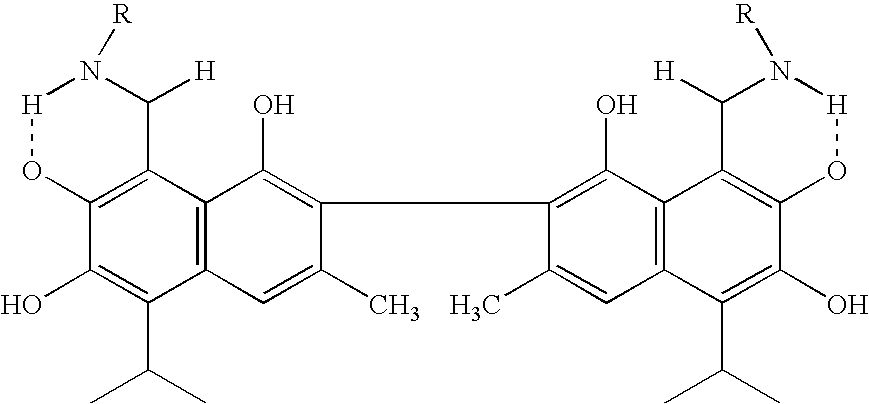Small molecule antagonists of BCL-2 family proteins
- Summary
- Abstract
- Description
- Claims
- Application Information
AI Technical Summary
Benefits of technology
Problems solved by technology
Method used
Image
Examples
example 1
Homology Modeling
[0470] The sequence of human Bcl-2 was obtained from Gene Bank (entry gi4557355) (SEQ ID NO:1). (See, FIG. 1). The NMR structure of Bcl-X.sub.L (pdb code: 1BXL from the protein databank), which has 45% amino acid sequence identity, 56% sequence similarity and 3% gaps with Bcl-2, was used as the template. The structure of Bcl-2 was built using the homology-modeling program MODELLER (version 4.0). (A. Sali et al., Structure, Function, and Genetics, 23:318-326 (1995); and A. Sali, Curr. Opin. Biotech., 6:437-451 (1995)). Further refinement was done using the molecular dynamics program CHARMM (version 27b2). (B. R. Brooks, J. Comput. Chem., 4:187-217 (1983)). Hydrogen atoms were assigned to the modeled structure using the program QUANTA (Molecular Simulations Inc., San Diego, Calif.). The Bak BH3 peptide was placed into the Bcl-2 BH3 domain binding site in the same orientation as in the NMR structure of Bcl-X.sub.L in complex with the Bak BH3 peptide (1BXL in protein da...
example 2
Expression and Purification of the Bcl-X.sub.L Protein
[0472] Recombinant Bcl-X.sub.L protein with a N-terminal His-tag was overexpressed from the pET15b expression vector (Novagen, Darmstadt, Germany). In this construct, the putative C-terminal membrane-anchoring region (residues 214-237) and a loop between helix 1 and helix 2 (residues 49-88) were removed to facilitate protein purification. This loop was previously shown to be dispensable for the anti-apoptotic activity of the protein. (See, S. W. Muchmore et al., Nature, 381:335-341 (1996)). The current construct of Bcl-X.sub.L produces about 20 mg of the purified Bcl-X.sub.L protein from 1 L of cell culture.
[0473] The protein samples for NMR studies were uniformly labeled with .sup.15N for screening and uniformly double labeled with .sup.15N and .sup.13C for structure characterization according to the methods described in M. Jansson et al., J. Biomol. NMR, 7:131-141 (1996), and M. L. Cai et al., J. Biomol. NMR, 11:97-102 (1998).
example 3
Resolution of (-)-Gossypol and (+)-Gossypol from Racemic Gossypol
[0474] Racemic gossypol acetic acid purchased from the National Cancer Institute (Bethesda, Md.) or commercial sources (e.g., Sigma-Aldrich Corp., St. Louis, Mo.) was dissolved in diethyl ether, washed twice with water to remove the acid and the ether layer was concentrated by rotary evaporation. To a solution of 1.04 g of gossypol (2 mmol) in 50 ml of CH.sub.2Cl.sub.2 was added 1 g of L-phenylalanine methyl ester hydrochloride (4.6 mmol), 0.4 g of NaHCO.sub.3 (4.7 mmol), 3 g of 4 .ANG. molecular sieves, and 1 ml of 2-propanol, the resulting mixture was stirred at room temperature overnight under N.sub.2 in the dark and filtered. The L-phenylalanine methyl ester reacts with the aldehyde groups of gossypol to form a Schiff's base with two diastereoisomers which were then resolved on a normal silica flash chromatography column. The filtrate was concentrated, and the residue was purified by chromatography on silica gel el...
PUM
| Property | Measurement | Unit |
|---|---|---|
| Volume | aaaaa | aaaaa |
| Mass | aaaaa | aaaaa |
| Mass | aaaaa | aaaaa |
Abstract
Description
Claims
Application Information
 Login to View More
Login to View More - R&D
- Intellectual Property
- Life Sciences
- Materials
- Tech Scout
- Unparalleled Data Quality
- Higher Quality Content
- 60% Fewer Hallucinations
Browse by: Latest US Patents, China's latest patents, Technical Efficacy Thesaurus, Application Domain, Technology Topic, Popular Technical Reports.
© 2025 PatSnap. All rights reserved.Legal|Privacy policy|Modern Slavery Act Transparency Statement|Sitemap|About US| Contact US: help@patsnap.com



